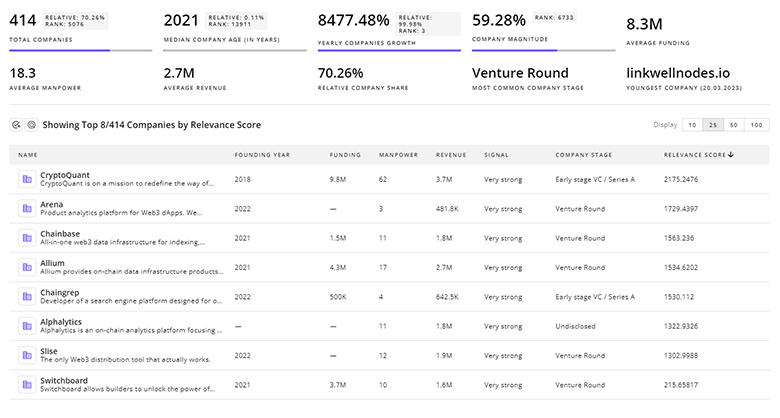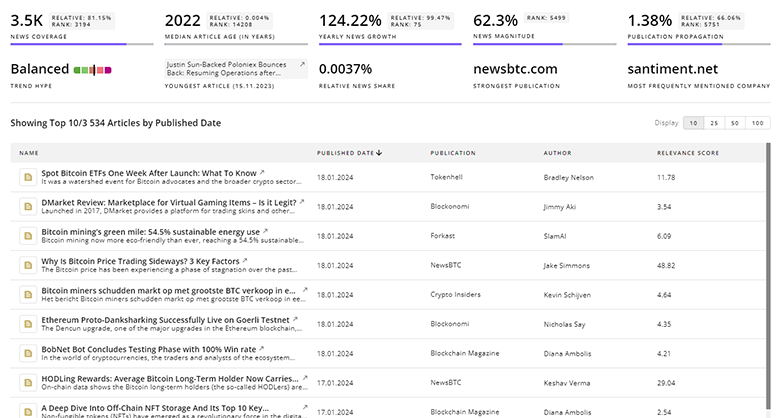
Predictive Analytics Report
: Analysis on the Market, Trends, and TechnologiesThe predictive analytics market is reaching commercial scale: the internal trend data reports a 2023 market size of $15.7 billion and a forecast to $91.93 billion by 2032 at a 21.7% CAGR, signaling sustained high-growth opportunity for vendors that solve integration, data-quality, and real-time inference challenges Predictive Analytics Market 2025: Detailed Insights into Market Size and Future Growth.
The last time we updated this report was 25 days ago. If there’s something missing or off, your tips are welcome!
Topic Dominance Index of Predictive Analytics
The Dominance Index for Predictive Analytics merges timelines of published articles, newly founded companies, and global search data to provide a comprehensive perspective into the topic.
Key Activities and Applications
- Demand and inventory forecasting: short- and mid-horizon forecasts for retail and supply chains to reduce stockouts and excess inventory; enterprise adoption grows as cloud ERP vendors embed predictive modules Global Predictive Analytics in ERP Market Size.
- Customer behavior and CLV modeling: propensity scoring, churn prediction and next-best-action orchestration that feed real-time marketing and retention systems Predictive Analytics Market Size, Share, Competitive Landscape (Allied Market Research).
- Fraud, risk scoring and compliance: pattern and anomaly detection for transaction monitoring, credit risk and regulatory reporting in BFSI and insurance Predictive and Prescriptive Analytics – Market Share Analysis (ResearchAndMarkets).
- Predictive maintenance and operational optimization: sensor -> model -> scheduled intervention pipelines in manufacturing, energy and transport Predictive Analytics Market Size – Industry Analysis Report (GMI Insights).
- Clinical outcome and population-health forecasting: early deterioration alerts, resource planning and risk stratification tied to EHR and wearable streams Predictive Analytics Market Report (IMARC Group).
- Real-time decisioning and edge inference: low-latency scoring for IoT, digital twins and operations control that require on-site model execution Predictive Analytics Tools Market Report 2025.
Emergent Trends and Core Insights
- Platform consolidation plus vertical specialization: buyers prefer integrated platforms that cover data ingestion, automated feature engineering, model governance and deployment, while high-value niches continue to pay premiums for verticalized domain expertise Predictive Analytics Market (Roots Analysis).
- Real-time and edge scoring growth: streaming architectures and edge inference are moving from pilots to production in manufacturing, energy and logistics where sub-second actions matter.
- Generative and large-model augmentation for feature engineering and scenario simulation: LLMs are increasingly used to expand feature sets, synthesize time-series contexts, and generate human-readable explanations for model outputs.
- Automated ML + MLOps to address talent shortage: AutoML, automated feature pipelines and standardized MLOps reduce dependence on scarce data-science teams and shorten time-to-value.
- Explainability and governance as procurement gates: regulated sectors and enterprise procurement increasingly require traceable model reasoning, audit trails and model-performance SLAs.
- Sustainability/ESG use cases: prediction of energy consumption, emissions and waste to support operational reductions and regulatory reporting.
Technologies and Methodologies
- Tree-based ensembles and boosted methods (XGBoost, LightGBM) remain the workhorse for tabular business data with high interpretability and fast retraining.
- Deep time-series architectures (TFT, Temporal CNNs, Transformers) and probabilistic forecasting for demand, load and sensor prediction deliver step changes in horizon accuracy.
- Probabilistic models and uncertainty quantification (Bayesian approaches, ensembles) to convert point forecasts into risk envelopes for decisioning under uncertainty.
- Graph-based ML for relational problems (supply-chain networks, fraud rings) where edges and propagation effects matter Predictive Analytics Market – Historic Data & Forecasts (ResearchNester).
- Streaming analytics and event processing (Kafka, Flink, edge SDKs) to support continuous training and sub-second scoring pipelines.
- No-code/low-code AutoML and template marketplaces to accelerate model reuse and reduce technical onboarding friction.
Predictive Analytics Funding
A total of 5.1K Predictive Analytics companies have received funding.
Overall, Predictive Analytics companies have raised $181.2B.
Companies within the Predictive Analytics domain have secured capital from 20.1K funding rounds.
The chart shows the funding trendline of Predictive Analytics companies over the last 5 years
Predictive Analytics Companies
- Pecan AI
Pecan AI offers a code-free predictive platform focused on business teams; it combines automated feature engineering with prebuilt vertical templates that shorten pilot cycles and enable faster enterprise consumption. Pecan’s Predictive GenAI features aim at letting non-technical users run scenario analysis and extract actionable recommendations without deep ML skills. - PredictiveWorks.
PredictiveWorks. provides a declarative, code-free platform for building, sharing and operationalizing predictive templates inside enterprises. The company emphasizes reusability and governed model libraries that match procurement and audit requirements in regulated industries. - Spectral AI
Spectral AI focuses on clinical diagnostic prediction using imaging and multimodal clinical data; its DeepView® product provides early wound-healing and burn prognosis that reduce length-of-stay risk and support clinical triage. The company scores high in vertical accuracy metrics used in pilot deployments with healthcare partners. - Predyktable
Predyktable builds retail and CPG forecasting solutions that combine consumer signals with supply-chain telemetry; clients report measurable reductions in waste and improved on-shelf availability through short-horizon replenishment models. The firm targets mid-market retailers that need fast ROI on forecasting projects. - TangentWorks
TangentWorks specializes in automated feature engineering and continuous model rebuilding for time-series problems; its auto-retraining engines reduce model decay risk and lower the staffing needs for repetitive forecasting tasks in utilities and manufacturing.
Delve into the corporate landscape of Predictive Analytics with TrendFeedr’s Companies tool

24.0K Predictive Analytics Companies
Discover Predictive Analytics Companies, their Funding, Manpower, Revenues, Stages, and much more
Predictive Analytics Investors
TrendFeedr’s Investors tool provides insights into 17.1K Predictive Analytics investors for you to keep ahead of the curve. This resource is critical for analyzing investment activities, funding trends, and market potential within the Predictive Analytics industry.

17.1K Predictive Analytics Investors
Discover Predictive Analytics Investors, Funding Rounds, Invested Amounts, and Funding Growth
Predictive Analytics News
TrendFeedr’s News feature offers you access to 22.3K articles on Predictive Analytics. Stay informed about the latest trends, technologies, and market shifts to enhance your strategic planning and decision-making.

22.3K Predictive Analytics News Articles
Discover Latest Predictive Analytics Articles, News Magnitude, Publication Propagation, Yearly Growth, and Strongest Publications
Executive Summary
Predictive analytics has moved from experimental projects to revenue-generating operations. The strongest commercial opportunities lie where models integrate tightly with workflows (CRM, ERP, maintenance systems), deliver measurable KPIs and provide auditable reasoning for regulated buyers. Vendors that package predictable outcomes (reduced downtime, improved fill rates, lower fraud loss) as measurable service guarantees will win procurement cycles. At the same time, enterprises must invest in data governance, continuous model maintenance and decisioning pipelines to capture the projected market growth. The strategic winners will combine vertical data assets, automated model lifecycles and clear outcome metrics to convert predictive insights into repeatable business value.
Are you an insider in the trends or tech industry? We’d love for you to contribute to our content.








